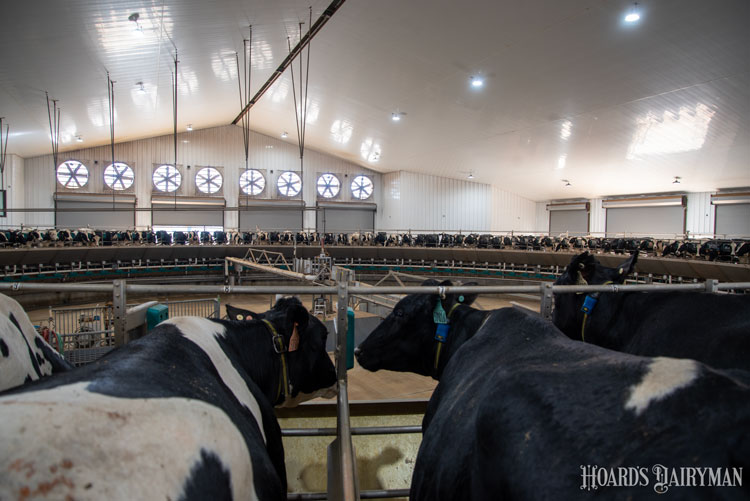The author is a vet who runs UdderWise Ltd., United Kingdom. To learn more about the author, visit his website at www.udderwise.co.uk.

Wow! That’s amazing! So impressive. My routine is nothing like this,” were the comments that came back when I sent a short video clip of the milking routine from Marik’s farm in Slovakia. Marik milks just over 2,000 cows three times a day and the average yield is over 40 liters or 88 pounds of milk. Cows are milked in a 70-stall rotary parlor with an eight-minute rotation, allowing just under seven seconds per task for each of the milkers.
The first thing you notice is that the parlor and building are spotless. It was built five years ago, and I first visited just as they swapped the old herringbone parlor for the rotary.
Standards are very high on this farm. The milkers have been well-trained. I carried out some of this training, explaining what we are trying to achieve and the importance of each role for every milker. Management then follows up with training regularly.
Training is valued
At the training session during my most recent visit, the milkers had so many questions and some great suggestions to make things even better. Some people think that training is a waste of time, but from my experience, it really helps people, makes them feel valued, is stimulating, and allows them to do a much better job. Training should be ongoing and questions and discussion encouraged.
The cows are keen to come onto the platform to be milked. Only a few cows need pushing. There are five milkers and a supervisor. The milkers rotate tasks so that they all work at each of the five milking positions throughout the milking to balance out the workload and to avoid boredom. The supervisor covers milkers when they take a break or when mastitic or other problem cows enter the parlor.
All milkers wear clean uniforms and gloves. The first milker puts their hand into a bucket of predip foam and strips each of the teats twice. It’s much easier to forestrip when hands are wet. Hands are rinsed in the bucket of disinfectant between stripping each cow.
If a cow is identified with mastitis, it is milked into a dump bucket and then separated. It then joins the hospital pen and thus comes onto the platform at the end of milking. In that way, the cow is milked twice before treatment is decided on.
The person predipping is immediately to the right of the milker stripping out milk, and that person applies a foam predip using a power foamer. The foam is blue, covers well, is easy to see, and stays on until the foam is wiped off by the third milker. This person is about 30 seconds away from the person predipping. Individual cloth towels are used to wipe teats clean. One wipe dries the outsides of the teats. The cloth is then flipped over and the teat ends are dried. Teats are spotlessly clean after drying.
Cloth towels are washed through an industrial washing machine at 195°F (90°C) and then put into a tumble dryer. You need to wash in hot temperatures to kill any bacteria. Some herds wash at 105°F (40°C) to save energy costs, but this does not kill bacteria. The cloths here are changed every four months or earlier if they are worn. Clean cloths are wheeled out in supermarket carts, and the dirty towels are thrown into a different cart.
Milk filters are put on a rack and checked by the supervisors. If the filters are dirtier than previous shifts, they will talk to the milkers so that they can improve at their next shift.
A well-oiled machine
Units are attached at 90 to 120 seconds after stripping. The timing of each of the tasks is important to make the most of the letdown reflex to maximize milking speed. Milkers stay on their colored floor mats so they remain in the correct location. There are wooden platforms that can be moved into place so that people are at the correct height in relation to the platform.
The units are attached easily, with all four shells held in the hands and the front two then the rear two shells attached. Milk starts flowing fast once the shells are attached. There is no bimodal milking or double letdown.
Milking speed is very fast. Peak flow occurs between 15 and 30 seconds after attachment. Between 52% and 62% of milk is removed in the first two minutes. The average unit on time for the highest yielders is under five minutes.
Automatic cluster removal units (ACRs) remove the clusters. Teat condition is monitored monthly. Teat damage or hyperkeratosis is not a problem. Teats are postdipped manually and any dirty clusters are hosed off. The machine is serviced monthly and liners are changed at the correct frequency.
This is without a doubt the best milking routine I have ever seen. Even toward the end of milking, when people will start to become tired, the standards don’t fall. I made sure to tell the milking team this so they were well aware that their hard work is valued.
It’s a pleasure to see such a team in action. The milkers have seen that their good routine has reduced the incidence of clinical mastitis, which slows down milking. This good parlor routine is one of the main reasons why mastitis levels have fallen by two-thirds over the last four years.





